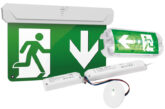
Peter Adams, Technical Manager at NVC Lighting, looks at why the choice of batteries for emergency lighting can help to achieve energy and cost savings.
Emergency lighting is required by law for all commercial premises and HMOs for illumination when the normal lighting fails. It is mandated by the Regulatory Reform (Fire Safety) Order 2005, more often called the fire safety order or the RRO and also Building Regulations.
For emergency lighting systems, the battery must be a rechargeable type and so the choice of battery can impact the amount of energy consumed, due to the way it is charged.
Battery types
Traditionally the most popular batteries used in self-contained fixtures were Nickel-Cadmium (Ni-Cad). A mainstay for emergency lighting applications, Ni-Cd has been used for many years due to its robust nature and ability to operate in harsh environments such as integral luminaire conversions.
A drawback is that the battery has a relatively low energy density (size to capacity ratio), making it unsuitable for fitting into newer, more discreet LED luminaires. A further disadvantage is that Cadmium is a hazardous chemical which brings end of life disposal and recycling challenges.
Battery charging and energy consumption
Emergency lighting is parasitic. This means that in normal situations it is in ‘standby’ mode, and its effects will not be seen unless there is a power failure. Despite this, the battery must remain fully charged and ready to provide emergency illumination when required. For this reason, the way the battery is charged influences the amount of parasitic energy consumed.
Ni-Cd batteries prefer to be constant current charged, resulting in almost all the delivered load being consumed by the charge duty. This also results in energy lost as heat as the current is continually passed through the battery. Using Ni-Cd, a typical 3W non-maintained luminaire consumes around 2.5W of power per hour.
New technology
More recently, the self-contained emergency lighting sector has seen a transformation in its impact on parasitic energy consumption with the advent of Lithium based battery technologies; in particular, Lithium Iron-Phosphate (LiFePO₄), the preferred choice for the industry.
Its very high-density energy (size to capacity ratio), coupled with its cell chemistry means LiFePO₄ is perfectly set up for self-contained emergency lighting. It has a high-temperature tolerance (higher than Ni-Cd), making it extremely versatile for luminaire integral conversions, and its lack of heavy metals and hazardous chemicals make it kinder to the environment and easier to recycle.
A major benefit of LiFePO₄ is that it prefers to be intermittently charged rather than constant current charged. This means that once the battery is fully charged, the battery charger switches off, typically for around four minutes out of every five, before undertaking ‘top up’ charging for one minute out of every five.
As well as being much kinder to the battery, this results in a far more efficient charge cycle which, coupled with Lithium’s much lower self-discharge rate, (3-5% per month compared to 10-20% per month for Ni-Cd), means that using LiFePO₄, a typical 3W non-maintained luminaire will consume around 0.7W of charging power. Assuming an average price of electricity of £0.145/KWh and a parasitic usage of 24hrs/day, the savings can be calculated in monetary terms on an annual basis as follows:
NVC SENECA using Ni-Cd
Charging power: 2.3W
(2.3 x 24) = 55.2 watt-hours/day/1,000 = 0.0552kWh/day (x 0.30) = 0.17 pence
0.17 x 365 = circa £6.20 annually
NVC SENECA PRO using LiFePO₄
Charging power: 0.7W
(0.7 x 24) = 16.8 watt-hours/day/1,000 = 0.0168kWh/day (x 0.30) = 0.05 pence
0.05 x 365 = circa £1.80 annually
This equates to an average saving of £4.40 per luminaire, per year, every year!
A further benefit of the intermittent charge cycle, coupled with the lower self-discharge rate is that LiFePO₄ has a much greater design life (up to eight years compared to the four years of Ni-Cad) resulting in much lower maintenance costs, a lower need for recycling and less cost for replacements.
At NVC we’re committed to Lithium technology. Our dedicated PRO emergency luminaire range already uses LiFePO₄ and by the end of 2021 we aim to replace all of our Ni-Cd offerings with the technology. This offers our customers peace of mind in the knowledge that they have a robust and compliant emergency lighting system that provides significant savings on parasitic energy usage, financial gains, and less environmental impact.
Our PRO range is also complemented by an automatic self-test facility which tests in line with BS EN 50172:2004 and BS EN 60234:2012. This negates the need for costly and time-consuming manual testing and maintenance, bringing about substantial payback over time.
Such is our confidence in LiFePO₄ technology, we now offer a seven-year warranty on all of our contractor range of products, and our PRO range of dedicated emergency luminaires, including the battery.
To browse the NVC UK Emergency Lighting brochure, click here









